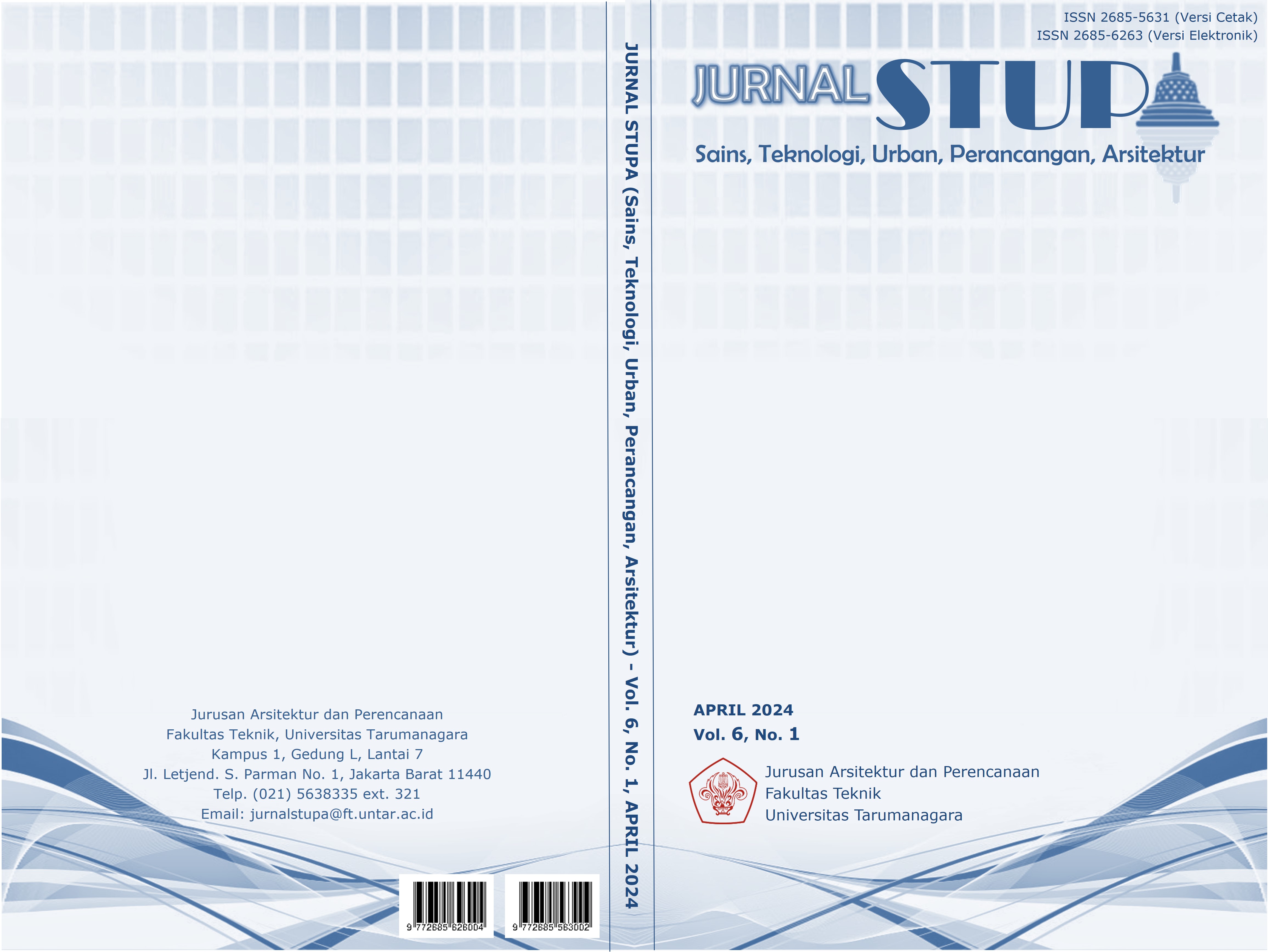SARANA PEMULIHAN FISIK DAN PSIKOLOGIS BAGI PASIEN PALIATIF STROKE DAN KELUARGA DI SULAWESI UTARA
Main Article Content
Abstract
Many Indonesian people suffer from stroke, especially in old age, residing in North Sulawesi. Inadequate hospital conditions, both in facilities and design, can cause stress or psychological effects on stroke patients. Stroke requires special treatment, such as that offered by specialized hospitals, covering physical, psychological, and emotional aspects. This research is designed to develop effective solutions to reduce the negative impact of strokes and improve the quality of life for patients and families, especially in spatial design and arrangement. The comparative method is used to determine the differences among various hospital typologies to produce a new hospital building typology by including elements that are requirements for palliative care. In the analysis process, qualitative methods were used to obtain something ideal for stroke sufferers. The study reveals that currently, stroke patient treatment in general hospitals largely follows general medical service guidelines. To become a special hospital (political stroke), it must be improved through new findings, such as spaces that are able to create a cheerful, free, spacious, cool, comfortable atmosphere without worrying, including a space for increasing faith. The next finding is that a free atmosphere and other requirements are impossible to find in a treatment room with a large capacity. In this research, a spatial planning simulation was successfully carried out. The conclusion for further steps is how to create a hospital for palliative patients with a large capacity due to the socio-economic conditions of the Indonesian people, but that can provide a much more comfortable atmosphere in terms of space.
Keywords: recovery; physical; psychological; stroke palliative
Abstrak
Penyakit stroke banyak diderita masyarakat Indonesia khususnya di usia senja, termasuk masyarakat di Sulawesi Utara. Kondisi rumah sakit yang tidak memadai dari segi fasilitas dan desain bisa menambah stress atau menimbulkan efek psikologis pasien stroke. Stroke memerlukan perawatan khusus, seperti yang disediakan oleh Rumah Sakit Khusus, mencakup aspek fisik, psikologis, dan emosional. Penelitian ini dirancang untuk mengembangkan solusi efektif mengurangi dampak buruk dari penyakit stroke dan meningkatkan kualitas hidup bagi pasien dan keluarga khususnya dalam desain dan penataan ruang. Metode komparatif digunakan untuk mengetahui perbedaan antara tipologi rumah sakit satu dan lainnya untuk menghasilkan tipologi bangunan rumah sakit baru dengan memasukkan unsur-unsur yang menjadi persyaratan penurunan paliatif. Dalam proses analisis digunakan metode kualitatif untuk mendapatkan sesuatu yang ideal bagi penderita stroke. Hasil penelitian ini menyatakan bahwa saat ini, penanganan pasien stroke di rumah sakit umum sebagian besar mengikuti pedoman pelayanan medis umum di rumah sakit. Untuk menjadi rumah sakit yang bersifat khusus (paliatik stroke) harus diperbaiki melalui temuan–temuan baru seperti ruang–ruang yang mampu menciptakan suasana ceria, bebas, luas, sejuk, nyaman, tanpa cemas disertakan pula ruang peningkatan iman. Temuan berikutnya suasana bebas dan persyaratan lainnya tidak mungkin ditemukan pada ruang perawatan dengan kapasitas besar. Dalam penelitian ini berhasil dilakukan simulasi penataan ruang. Kesimpulan untuk langkah lebih lanjut adalah bagaimana menciptakan rumah sakit penderita paliatif dengan kapasitas besar karena kondisi sosial ekonomi masyarakat Indonesia namun bisa memberikan suasa yang jauh lebih nyaman secara ruang.
Article Details

This work is licensed under a Creative Commons Attribution-NonCommercial-ShareAlike 4.0 International License.
This work is licensed under a Jurnal Sains, Teknologi, Urban, Perancangan, Arsitektur/ STUPA Creative Commons Attribution-NonCommercial-ShareAlike 4.0 International LicenseReferences
Atkinson, R. L., Atkinson, R.C., Hilgard, E.R., (1999). Pengantar Psikologi. Diterjemahkan oleh N. Taufiq, disunting oleh A. Dharma. Jakarta: Erlangga.
De Vignemont, F., dan Singer, T. (2006). The empathic brain: How, when and why? Trends in Cognitive Sciences, 10(10), 435–441. https://doi.org/10.1016/j.tics.2006.08.008
Decety, J., dan Jackson, P. L. (2006). A Social-Neuroscience Perspective on Empathy. Current Directions in Psychological Science, 15(2), 54–58. https://doi.org/10.1111/j.0963-7214.2006.00406.x
Dinata, C. A., Safrita, Y. S., dan Sastri, S. (2013). Gambaran Faktor Risiko dan Tipe Stroke pada Pasien Rawat Inap di Bagian Penyakit Dalam RSUD Kabupaten Solok Selatan Periode 1 Januari 2010—31 Juni 2012. Jurnal Kesehatan Andalas, 2(2), 57. https://doi.org/10.25077/jka.v2i2.119
Holland, P., dan Bardoel, A. (2016). The impact of technology on work in the twenty-first century: Exploring the smart and dark side. The International Journal of Human Resource Management, 27(21), 2579–2581. https://doi.org/10.1080/09585192.2016.1238126
Jpnn.com. (2014). Penderita Stroke Terbanyak Ada di Sulawesi Utara. Diunduh dari https://www.jpnn.com/news/penderita-stroke-terbanyak-ada-di-sulawesi-utara
Junaidi, I. (2013). STROKE, Waspadai Ancamannya. Yogyakarta: Andi.
Nurwijaya, D. H. (2013). Cegah Dan Deteksi Kanker Serviks. Jakarta: Elex Media Komputindo.
Pallasmaa, J. (2012). The eyes of the skin: Architecture and the senses. Chichester, Est Sussex, United Kingdom : Wiley, A John Wiley and Sons, Ltd, Publication. http://archive.org/details/eyesofskinarchit0000pall
Palliative care. (n.d.). Retrieved 11 January 2024, from https://www.who.int/news-room/fact-sheets/detail/palliative-care
Pratiwi, K. P., Purnomo, M. D. E., dan Muqoffa, M. (2017). Rumah Sakit Khusus Stroke dengan Penerapan Healing Environment di Sukoharjo. Arsitektura, 15(1), Article 1. https://doi.org/10.20961/arst.v15i1.11650
Rasjidi, I. (2009). Pengaruh Model Interdisiplin Pasien Kanker Serviks Stadium Lanjut Dengan Gangguan Fungsi Ginjal terhadap Efektivitas dan Biaya Perawatan. Indonesian Journal of Cancer, 3(4), Article 4. https://doi.org/10.33371/ijoc.v3i4.133
Rohaniah, L., Aldy, P., dan S, M. D. (2018). Rumah Sakit Stroke Di Pekanbaru Dengan Pendekatan Arsitektur Perilaku. Jurnal Online Mahasiswa (JOM) Bidang Teknik dan Sains, 5(0), Article 0.
Sari, F. A. (2021). Hubungan Dukungan Keluarga dengan Kualitas Hidup pada Pasien Pasca Stroke. Universitas Binawan 28.
Kebijakan Kesehatan Indonesia. (2010). Diakses 12 January 2024, dari https://kebijakankesehatanindonesia.net/25-berita/berita/1428-setiap-tahun-terdapat-550000-pasien-baru-stroke-di-indonesia
Setiawan, D., dan Barkah, A. (2022). Hubungan Dukungan Keluarga Terhadap Motivasi Pasien Pasca Stroke Dalam Melakukan Latihan Fisioterapi di Rs. Sukmul Sisma Medika Jakarta Utara Tahun 2022. Jurnal Pendidikan Dan Konseling (JPDK), 4(3), Article 3. https://doi.org/10.31004/jpdk.v4i3.4947
Tambunan, E. K., Siahaan, U., dan Sudawarni, M. M. (2021). Pengaruh Ruang Terbuka Hijau Terhadap Psikologis Masyarakat di Kota Bekasi Khususnya Kecamatan Jatiasih. ARSITEKTURA, 19(2), Article 2. https://doi.org/10.20961/arst.v19i2.53995
Twenge, J. M., dan Campbell, W. K. (2009). The narcissism epidemic: Living in the age of entitlement (pp. viii, 339).
Wardhani, I., dan Martini, S. (2015). The Relationship between Stroke Patients Characteristics and Family Support with Compliance Rehabilitation. Jurnal Berkala Epidemiologi, 3, 24. https://doi.org/10.20473/jbe.v3i1.2015.24-34
Widakdo, G., dan Besral, B. (2013). Efek Penyakit Kronis terhadap Gangguan Mental Emosional. Kesmas: Jurnal Kesehatan Masyarakat Nasional (National Public Health Journal), 7(7), Article 7. https://doi.org/10.21109/kesmas.v7i7.29
World Health Organization. (2020, Agustus 5). Perawatan Paliatif. https://www.who.int/news-room/fact-sheets/detail/palliative-care



